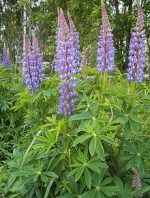 Also called many-leaved lupine, blue-pod lupine, marsh lupine, and Washington lupine, this herbaceous perennial is native to western North America from southern Alaska and British Columbia east to Quebec and western Wyoming and south to Utah and California where it grows in moist habitats such as in meadows and along streams and creeks. Plants grow up to 4 3/4′ tall from a rhizomatous base and have stout hollow stems bearing palmately compound leaves with 9-17 narrow leaflets up to almost 6″ long, glabrous above, sparsely stiff-hairy below. From late spring to early summer, racemes of pea-like flowers appear. Each blue to purple flower is .39-.59″ long and consist of an erect standard, 2 wing petals, and an incurved keel. The fruit is a flat, curved pod 1-2″ long, covered with soft hairs and containing 6-10 grayish seeds with dark mottling. L. polyphyllus has been used to produce some garden worthy plants including the Russel Hybrids but is considered more suitable for wildflower and native plant gardens. The seed pods are attractive in dried arrangements. The genus name, Lupinus, is the classical name for the plant derived from the Latin word lupus meaning wolf, and refers to the false belief the plants destroyed the soil. The specific epithet, polyphyllus, comes from the Greek prefix poly- meaning many and the Greek word phyllon meaning leaf and refers to the foliage.
Also called many-leaved lupine, blue-pod lupine, marsh lupine, and Washington lupine, this herbaceous perennial is native to western North America from southern Alaska and British Columbia east to Quebec and western Wyoming and south to Utah and California where it grows in moist habitats such as in meadows and along streams and creeks. Plants grow up to 4 3/4′ tall from a rhizomatous base and have stout hollow stems bearing palmately compound leaves with 9-17 narrow leaflets up to almost 6″ long, glabrous above, sparsely stiff-hairy below. From late spring to early summer, racemes of pea-like flowers appear. Each blue to purple flower is .39-.59″ long and consist of an erect standard, 2 wing petals, and an incurved keel. The fruit is a flat, curved pod 1-2″ long, covered with soft hairs and containing 6-10 grayish seeds with dark mottling. L. polyphyllus has been used to produce some garden worthy plants including the Russel Hybrids but is considered more suitable for wildflower and native plant gardens. The seed pods are attractive in dried arrangements. The genus name, Lupinus, is the classical name for the plant derived from the Latin word lupus meaning wolf, and refers to the false belief the plants destroyed the soil. The specific epithet, polyphyllus, comes from the Greek prefix poly- meaning many and the Greek word phyllon meaning leaf and refers to the foliage.
Type:n Herbaceous perennial
Bloom:Racemes of blue to purple pea like flowers from late spring to early summer
Size:4-5.75′ H x 1.5-2′ W
Light:Full sun to partial shade
Soil: Average, moist, well-drained, somewhat acidic, cool; does not do well in clay
Hardiness: Zones 4-9
Care: Low maintenance
Pests and Diseases: Crown rot in heavy soil
Propagation: Seed; fresh seed can be planted immediately but dried seed should be soaked for 12 hours in water heated to boiling in order to soften the very hard seed coat.
Companion Plants: Columbine, Salvia ‘May Night’, iris, peony, roses
Photo Credit: Wikipedia